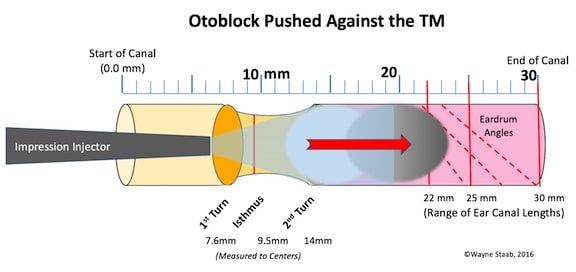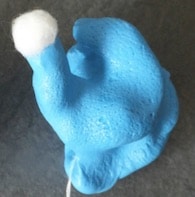“Do Not Let the otoblock come in contact with the eardrum.” Instructions such as this to individuals taking ear impressions has been the topic of post 1 and 2 providing evidence busting the ear impression otoblock myth suggesting such placement.
Otoblock to Protect the Eardrum?
The purported purpose is to protect the eardrum/tympanic membrane (TM), as so most sources say. Protect it from what? From ear impression material that might come in contact with the TM? Unless one has a perforated eardrum or some other unusual condition in which the ear impression material may pass through a perforation, there seems to be no evidence that ear impression material against the TM causes any damage. Thousands of ear impressions have been intentionally and successfully made against the TM without blocks (even some made unintentionally because of poor size/positioning of otoblocks). If the purpose was for protection, then the logical practice would be to place the otoblock so it comes in contact with the TM.
Won’t Placing the Otoblock Against the TM (Eardrum) be Dangerous and Damage the TM?
Won’t placing the block against the TM be dangerous and damage the TM? Keep in mind that a very high percentage of good ear impressions end up with the block in contact with the TM. So, why not put it there initially and reduce the number of errors and poor ear impressions that are still being made? A block is not a sharp item against the TM, but spreads out over the entire surface area. This assumes that the block is made of cotton (or similar material), rather than foam blocks. (I realize that many people use foam blocks, but, to me, foam blocks are often an accident waiting to happen. Besides, they seem to allow ear impression material to move around them fairly easily, and do not have the fibers of the cotton to catch and hold ear impression material attempting to push around the block).
A cotton block against the eardrum generates less pressure than individuals experience under water in the deep end of a swimming pool, no more than a mic probe making contact with the TM, most generally less than irrigation of the ear canal (which often also involves multiple violations of the TM), or any other number of ways the TM is exposed to the elements. If contact with the eardrum was damaging, then why don’t we see more eardrum trauma following the taking of ear impressions when we know that the injection insertion pressure forces the block against the TM?
Regardless, it is still incumbent upon the dispenser to have a very good understanding of the ear canal and its dimensions, to have a steady hand, good eyesight, the use of a headlamp or video otoscope, and to proceed slowly and carefully. Any individual not having these skills should not be taking ear impressions.
But, why not place the otoblock properly to begin with, as explained below.
Arguments for Placement of the Otoblock Against the TM
- Place the block against the TM to begin with. Horrors!!! I can see the crossed sticks coming out already and I think I just received at least five arrows in my butt (my largest target). However, it is easy to make arguments for intentional placement of the otoblock against the TM, and the burden of proof lies with those who argue against this practice.
- Its placement is obvious – the individual tells you that they can feel it against the TM. You know where it is. For those who place blocks and during the process the subject’s head moves away while making the insertion, that is a clear indication that the block has been pushed against the TM! If that has happened to you, how much damage have you been doing all these years even though you have been using the otoblock to “protect” the TM by supposedly not allowing it to come in contact with the TM?
- Why not just put the otoblock against the TM to begin with, because in essentially every good ear impression, that is where it ends up. So, why not start from a known and fixed position rather than an unknown and/or dubious location? If this length ear impression is not desired, use a long block, but still place it against the TM
- If there is a minor perforation, ear impression material is less likely to get past an otoblock against the TM than by blow-by of a poorly sized and placed otoblock. Of course, if there is a perforation, communication with an ENT should dictate any action. A video otoscope may be good, but screening tympanometry is even better for determination of a perforation.
- If protection of the eardrum is the intention, then protect the eardrum. The best place for the otoblock would be against the eardrum. Placement at any position other than this is protecting what – an empty ear canal? For example, to protect a knee, a brace is normally placed on the knee, not the foot, hoping that vibrations will be stopped at the foot level and not reach the knee.
- Many already place the otoblock against the TM, even if they are not aware of it. This is easily observed by the subject’s reaction. If their head moves, or it seems that you have “bottomed out” when placing the otoblock, you have made contact with the eardrum.
- The TM can withstand considerable pressure, and even more when pressure is distributed over its entire area.
- The lower the viscosity of the ear impression material, and the use of an appropriate syringe/gun for that material, ear impression material will have very little force when it encounters anything, including an otoblock or the TM itself.
- How good an ear impression is desired? If a good ear impression is desired, place the otoblock against the TM. This is not difficult. Tell the subject that it will be placed in the ear canal, and for them to let you know when it makes contact with the TM. Work slowly using insertion procedures generally taught. This should not be a test of Sampson bringing down the temple, but the block should be solid and tight. It makes more sense to have the subject let you know when the otoblock makes contact with the TM than for you to guess where it is, or to guess when it makes contact. In reality, the subject’s reaction (head pulling away) to the block against the TM generally comes before their verbal confirmation.
- If one wanted to make a poor ear impression…then why make an ear impression at all? Even today, earmold or custom hearing aid manufacturers will confirm that many of the ear impressions they receive are of poor quality – mostly, not being complete or deep enough.
- If you obtain an ear impression (minus the block) with a canal that is anywhere near 18 mm in length, it is almost certain that the otoblock ended up against the TM. This canal impression length could even be less for those having shorter ear canals.
- Most of the problem issues I have seen during 45 years in the hearing aid industry relate to blow-by of the impression material or too short and incomplete canal portion.
Consequences of a Poorly Placed Otoblock
There can be consequences of a poorly placed otoblock. If the otoblock made its way just through the narrow ear canal isthmus, the unknown is how it fills the interior of the ear canal. Certainly, one can use a video otoscope to try to make this determination, but that provides information only up to the point of the block. It can’t see beyond the block. If the otoblock does not fill the ear canal, it is possible that ear impression material may flow past the otoblock (“blow-by”). This, in itself, is not a catastrophe, even though it should be avoided, but usually does not provide the ear impression detail needed. But, blow-by should not even occur.
What is worse is when the ear impression material is injected into the ear canal, and then the head moves. You have just scored a direct hit on the TM – unintentionally. The injected impression material has moved the block against the eardrum (Figure 1) So, even if the intent was NOT to have the otoblock come in contact with the eardrum, the impression process most often does this for you. A potential problem may occur in that the block was not solid enough, and the injected material starts to form around the otoblock, or what is often referred to as “blow-by.” The main problem with blow-by is that it distorts that part of the ear impression that may be most critical to making a good earmold or custom-molded product.

Figure 1. The effect of a poorly-placed otoblock just past the isthmus. Upon injection of ear impression material, the force of the injection can easily push the otoblock against the TM. Of course, this depends on the viscosity of the ear impression material, the type of injector, and the force used to inject the material. Regardless, if the subject’s head moves away from the injection process, you can be assured that the impression material has driven the otoblock against the TM. (This image is replicated from Ear Impression Otoblock Myth – Part 2).
Perhaps one of the worst pieces of advice on otoblock placement and use is to apply tension on the otoblock string (supposedly to hold it in position) during impression injection. This is destined to do one of two things:
- Result in a short ear impression
- Guarantee blow-by
Whenever one sees ear impression material around the sides of the block, it should be obvious that the block was either too small, or that it was incorrectly placed.
Otoblock Myth
The otoblock should be placed just past the second bend of the ear canal and should not come into contact with the tympanic membrane. This is poor advice, and this series of posts explains why.






